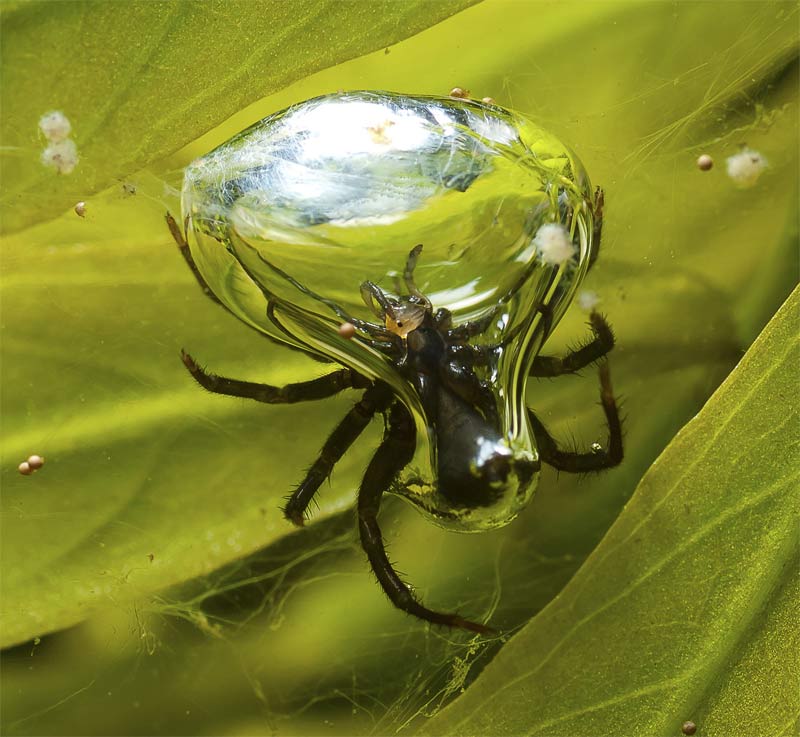Scuba Spiders: Diving Arachnids Can Breathe Underwater

Like eight-legged scuba divers, some spiders can breathe underwater using an air bubble as an oxygen tank of sorts. Now, scientists have figured out some of the fascinating details of this arachnid diving bell, including that it can give the spiders more than a day's worth of air.
While scientists knew diving bell spiders (Argyroneta aquatica) — spanning just 10 to 15 millimeters in length — used an air bubble to breathe underwater in lakes and ponds, this is the first study that measures exactly how that happens and calculates how long the spider could stay underwater before resurfacing to replenish its bubble with fresh air.
"We were surprised how low the oxygen in the bubble could get before the spiders venture to the surface," study researcher Roger Seymour, of the University of Adelaide, told LiveScience. [See images of the underwater spiders]
Diving bells
Seymour and Stefan Hetz from Humboldt University in Germany, brought diving spiders into the lab, placing them into tanks mimicking conditions of a stagnant pond on a hot summer's day — revealing how the animals fare in extreme, low-oxygen conditions.
Immediately, most of the spiders constructed webs between the pondweeds and aquarium sides. Then each spider came to the surface to collect a large air bubble held between the hydrophobic (water-repelling) hairs on its abdomen and its rear legs. Webbing was placed around the lower sides of this gas chamber, which the spiders entered from the bottom.
Some spiders created chambers just large enough to enclose their abdomens, leaving their rears and rear legs hanging out; others had larger bubbles that enclosed their entire bodies. For instance, the spiders would enlarge the bubble by laying down more web and adding air before pulling just-snagged prey into the chamber.
Get the world’s most fascinating discoveries delivered straight to your inbox.
Tiny sensors measured oxygen levels inside the bubbles and in the surrounding water, finding that the spiders extracted oxygen from the water as if it were a gill; the sensors also showed that the spiders could survive on very low oxygen levels.
Shrinking bubbles
Even so, the bubble shrinks over time and forces the spider to resurface for a fresh one. Like the atmosphere, the bubble contains primarily both oxygen and nitrogen, and as the spider takes oxygen from the bell, the nitrogen must increase. That increase pushes nitrogen out of the bubble by diffusion. Eventually, the lab spiders had to resurface.
The tiny spiders still were able to sit tight for more than a day, much longer than previous estimates suggesting a 20-minute underwater stint.
"It is advantageous for the spiders to stay still for so long without having to go to the surface to renew the bubble, not only to protect themselves from predation, but also so they don't alert potential prey that come near," Seymour said.
The research is detailed in the current issue of the Journal of Experimental Biology.
Follow LiveScience for the latest in science news and discoveries on Twitter @livescience and on Facebook.
Jeanna Bryner is managing editor of Scientific American. Previously she was editor in chief of Live Science and, prior to that, an editor at Scholastic's Science World magazine. Bryner has an English degree from Salisbury University, a master's degree in biogeochemistry and environmental sciences from the University of Maryland and a graduate science journalism degree from New York University. She has worked as a biologist in Florida, where she monitored wetlands and did field surveys for endangered species, including the gorgeous Florida Scrub Jay. She also received an ocean sciences journalism fellowship from the Woods Hole Oceanographic Institution. She is a firm believer that science is for everyone and that just about everything can be viewed through the lens of science.


